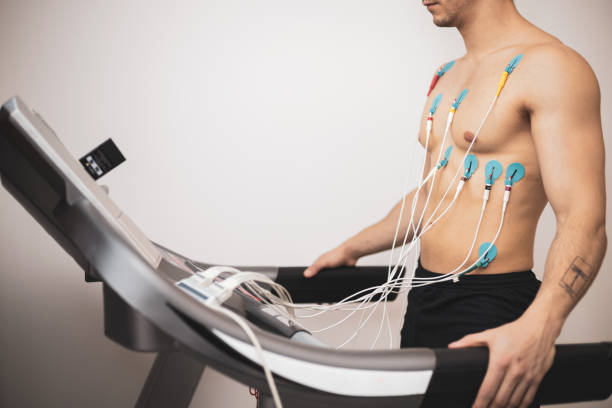Exercise Treadmill ECG, also known as exercise stress testing or treadmill testing, is a diagnostic procedure that assesses the heart’s response to physical exertion. It involves monitoring the electrocardiogram (ECG) while the patient walks or runs on a treadmill. This test is commonly used to evaluate cardiovascular health, identify heart-related issues, and assess exercise tolerance.
What Is Exercise Treadmill ECG?
Exercise Treadmill ECG or stress testing, is a diagnostic procedure assessing the heart’s response to physical exertion. Patients walk or run on a treadmill during this test while their heart rate, rhythm, blood pressure, and ECG are continuously monitored.
The objective is to evaluate cardiovascular performance under stress, enabling the identification of abnormalities, assessing exercise tolerance, and providing valuable insights into heart health. Gradually increasing the exercise intensity helps detect symptoms and observe real-time changes, making Exercise Treadmill ECG a valuable tool for diagnosing conditions like coronary artery disease, guiding further diagnostic steps and informing treatment decisions.
Who Needs Exercise Treadmill ECG?
Exercise treadmill ECG is a stress test typically recommended for individuals who may have symptoms of heart problems, such as chest pain or shortness of breath, during physical activity. It is commonly used to evaluate cardiac function and diagnose conditions like coronary artery disease. Additionally, it may be prescribed for individuals for screening of underlying coronary artery disease with specific risk factors for heart disease, providing valuable information about cardiovascular health under stress conditions.
How to Prepare For Exercise Treadmill ECG?
Wear comfortable clothing and shoes suitable for exercise, and avoid heavy meals before the test. Follow any medication instructions provided by your doctor and stay adequately hydrated. Limit caffeine intake on the test day, notify your doctor of any health changes, and discuss concerns beforehand. Your doctor may review your medical history, including previous heart-related tests, surgeries, or conditions.
Inform your doctor if you have any ailments that may prevent you from performing brisk walking on the treadmill such as joint pain or if you are generally feeling unwell on the day of the test. These guidelines ensure a smooth and practical Exercise Treadmill ECG experience, contributing to accurate and meaningful results.
What Happens During Exercise Treadmill ECG?
During Exercise Treadmill ECG, the process begins with baseline measurements of resting heart rate, blood pressure, and electrocardiogram (ECG) readings. Electrodes are attached to monitor heart activity, and you gradually walk or run on a treadmill with the intensity increasing over time.
Continuous monitoring of heart rate, rhythm, and ECG is conducted throughout the exercise while healthcare professionals observe for any symptoms. The test is supervised, and safety measures are in place to respond promptly to adverse reactions. Upon reaching a target heart rate or experiencing relevant symptoms, the exercise phase ends, and a brief recovery period follows.
The recorded data is then analysed to create a diagnostic report, summarising exercise capacity, symptoms, and abnormal ECG changes. A follow-up consultation is scheduled to discuss the results and determine if further diagnostic tests or treatment adjustments are necessary.
What To Do After Exercise Treadmill ECG?
After completing Exercise Treadmill ECG, there will be a brief recovery period with monitoring before, equipment is removed and patients can resume normal activities. Schedule a follow-up consultation with your doctor to review the test results. During this appointment, your doctor will discuss any abnormalities or changes observed during the test, correlate them with symptoms experienced, and provide tailored recommendations. Your doctor will establish a long-term management plan, and provide guidance on lifestyle modifications for ongoing cardiovascular health.
What are the Risks of an Exercise Treadmill ECG?
Exercise treadmill ECG, or stress testing, is generally safe, but there are some potential risks. The primary risk is related to physical exertion during the test, which may trigger chest pain, heart attack, or irregular heart rhythms in individuals with pre-existing heart conditions. Other risks may include that of accidental injury with use of the treadmill machine.
However, the likelihood of such events is low, and healthcare professionals closely monitor patients during the procedure. In rare cases, there may be complications such as dizziness, falls, or extremely rare instances of life-threatening events, emphasising the importance of proper patient selection and supervision during the test.







